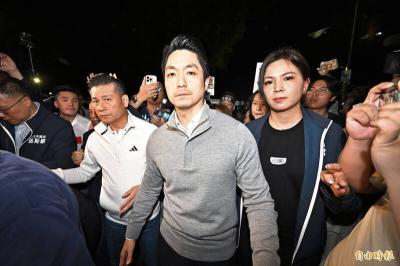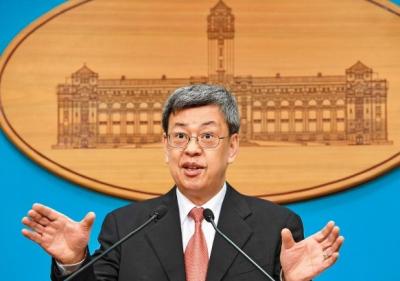Questions submitted by members of the public through an online platform for the presidential and vice presidential debates will be selected by drawing lots, Internet media outlet Watchout (沃草) said yesterday.
Watchout spokesman Lin Zu-yi (林祖儀) told a press conference in Taipei that only questions tendered on the platform — called “President, may I ask a question?” (總統,給問嗎?) — that have received at least 1,000 signatures from netizens will be considered for the draws.
“Since the platform was launched in October, it has received more than 4,000 questions that netizens want to ask the three pairs of presidential and vice presidential candidates competing in next month’s election,” Lin said, adding that 68 of the questions had met the 1,000-signature threshold as of yesterday.
Lin said that for the first and only vice presidential debate, which is scheduled to be held on Saturday, six out of 15 topics — including the economy, labor, finance, education, cross-strait ties, foreign affairs, healthcare and social welfare — are to be selected by drawing lots.
“For each topic, we will draw a question at random from a pool on Friday, so there will be six questions in total,” Lin said.
As for the second presidential debate planned for Jan. 2, one question will be drawn at random from each five out of the 15 subjects a day before, Lin said.
Questions posed by the public will only be asked in the two aforementioned televised debates, as the first presidential debate on Sunday will only take questions from media representatives.
The representatives of the three political parties participating in the debate welcomed the selection method.
Chinese Nationalist Party (KMT) presidential candidate Eric Chu’s (朱立倫) campaign spokesperson Hsu Chiao-hsin (徐巧芯) said the party welcomed such a fair and open question selection mechanism.
“Each question will be answered by all three candidates, which the KMT finds fair and supports 100 percent,” Hsu said.
Democratic Progressive Party Department of News and Information director Alex Huang (黃重諺) said there were many organizations aspiring to host the debates, but the online platform was the one that best fit the growing trend of openness in the nation’s public affairs.
“It allows people to directly participate in public affairs through the Internet, which is why it can best represent a diversity of public opinions,” Huang said.
People First Party Propaganda Department director Clarence Wu (吳崑玉) said the online platform has not only altered the manner in which the future head of state deals with the public, but can also bring about changes in the legislative mechanism for proposing bills.

Several Chinese Nationalist Party (KMT) officials including Chairman Eric Chu (朱立倫) are to be summoned for questioning and then transferred to prosecutors for holding an illegal assembly in Taipei last night, the Taipei Police said today. Chu and two others hosted an illegal assembly and are to be requested to explain their actions, the Taipei City Police Department's Zhongzheng (中正) First Precinct said, referring to a protest held after Huang Lu Chin-ju (黃呂錦茹), KMT Taipei's chapter director, and several other KMT staffers were questioned for alleged signature forgery in recall petitions against Democratic Progressive Party (DPP) legislators. Taipei prosecutors had filed

Taiwan would welcome the return of Honduras as a diplomatic ally if its next president decides to make such a move, Minister of Foreign Affairs Lin Chia-lung (林佳龍) said yesterday. “Of course, we would welcome Honduras if they want to restore diplomatic ties with Taiwan after their elections,” Lin said at a meeting of the legislature’s Foreign Affairs and National Defense Committee, when asked to comment on statements made by two of the three Honduran presidential candidates during the presidential campaign in the Central American country. Taiwan is paying close attention to the region as a whole in the wake of a

President William Lai (賴清德) has appointed former vice president Chen Chien-jen (陳建仁) to attend the late Pope Francis’ funeral at the Vatican City on Saturday on his behalf, the Ministry of Foreign Affairs said today. The Holy See announced Francis’ funeral would take place on Saturday at 10am in St Peter’s Square. The ministry expressed condolences over Francis’ passing and said that Chen would represent Taiwan at the funeral and offer condolences in person. Taiwan and the Vatican have a long-standing and close diplomatic relationship, the ministry said. Both sides agreed to have Chen represent Taiwan at the funeral, given his Catholic identity and

NEW WORLD: Taiwan is pursuing innovative approaches to international relations through economics, trade and values-based diplomacy, the foreign minister said Taiwan would implement a “three-chain strategy” that promotes democratic values in response to US tariffs, Minister of Foreign Affairs Lin Chia-lung (林佳龍) said. Taiwan would aim to create a “global democratic value chain,” seek to capitalize on its position within the first island chain and promote a “non-red supply chain,” Lin was quoted as saying in the ministry’s written report to the Legislative Yuan submitted ahead of the legislature’s Foreign Affairs and National Defense Committee meeting slated for today. The Ministry would also uphold a spirit of mutual beneficial collaboration, maintaining close communication and consultations with Washington to show that Taiwan-US cooperation